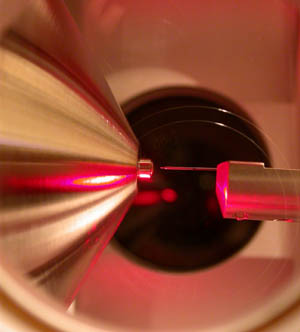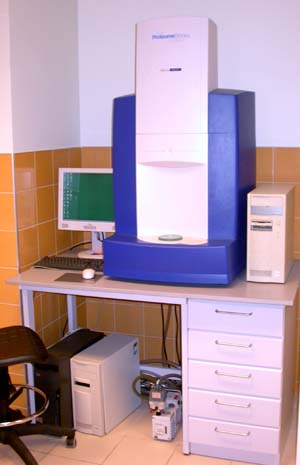|
Matrix-assisted Ionization
In mass spectrometry, matrix-assisted ionization (also inlet ionization) is a low fragmentation (soft) ionization technique which involves the transfer of particles of the analyte and Matrix (mass spectrometry), matrix sample from atmospheric pressure (AP) to the heated inlet tube connecting the AP region to the vacuum of the mass analyzer. Initial ionization occurs as the pressure drops within the inlet tube. Inlet ionization is similar to electrospray ionization in that a reverse phase solvent system is used and the ions produced are highly charged, however a voltage or a laser is not always needed. It is a highly sensitive process for small and large molecules like peptides, proteins and lipids that can be coupled to a Liquid chromatography–mass spectrometry, liquid chromatograph. Inlet ionization techniques can be used with an Orbitrap mass analyzer, Orbitrap Fourier transform ion cyclotron resonance, fourier transform mass spectrometer, Quadrupole ion trap, linear trap qua ... [...More Info...] [...Related Items...] OR: [Wikipedia] [Google] [Baidu] |
|
|
Inlet Ionization
In mass spectrometry, matrix-assisted ionization (also inlet ionization) is a low fragmentation (soft) ionization technique which involves the transfer of particles of the analyte and matrix sample from atmospheric pressure (AP) to the heated inlet tube connecting the AP region to the vacuum of the mass analyzer. Initial ionization occurs as the pressure drops within the inlet tube. Inlet ionization is similar to electrospray ionization in that a reverse phase solvent system is used and the ions produced are highly charged, however a voltage or a laser is not always needed. It is a highly sensitive process for small and large molecules like peptides, proteins and lipids that can be coupled to a liquid chromatograph. Inlet ionization techniques can be used with an Orbitrap mass analyzer, Orbitrap fourier transform mass spectrometer, linear trap quadrupole and MALDI-TOF. Types of inlet ionization Matrix-assisted inlet ionization In Matrix-assisted inlet ionization (MAII), ... [...More Info...] [...Related Items...] OR: [Wikipedia] [Google] [Baidu] |
|
|
2,5-dihydroxybenzoic Acid
Gentisic acid is a dihydroxybenzoic acid. It is a derivative of benzoic acid and a minor (1%) product of the metabolic break down of aspirin, excreted by the kidneys. It is also found in the African tree '' Alchornea cordifolia'' and in wine. Production Gentisic acid is produced by carboxylation of hydroquinone.Phillip M. Hudnall "Hydroquinone" in Ullmann's Encyclopedia of Industrial Chemistry 2002, Wiley-VCH, Weinheim. 2005 Wiley-VCH, Weinheim. . :C6H4(OH)2 + CO2 → C6H3(CO2H)(OH)2 This conversion is an example of a Kolbe–Schmitt reaction. Alternatively the compound can be synthesized from salicylic acid via Elbs persulfate oxidation. Reactions In the presence of the enzyme gentisate 1,2-dioxygenase, gentisic acid reacts with oxygen to give maleylpyruvate: :2,5-dihydroxybenzoate + O2 \rightleftharpoons maleylpyruvate Applications As a hydroquinone, gentisic acid is readily oxidised and is used as an antioxidant excipient in some pharmaceutical preparations. In the la ... [...More Info...] [...Related Items...] OR: [Wikipedia] [Google] [Baidu] |
|
 |
Liquid Chromatography
In chemical analysis, chromatography is a laboratory technique for the separation of a mixture into its components. The mixture is dissolved in a fluid solvent (gas or liquid) called the ''mobile phase'', which carries it through a system (a column, a capillary tube, a plate, or a sheet) on which a material called the ''stationary phase'' is fixed. Because the different constituents of the mixture tend to have different affinities for the stationary phase and are retained for different lengths of time depending on their interactions with its surface sites, the constituents travel at different apparent velocities in the mobile fluid, causing them to separate. The separation is based on the differential partitioning between the mobile and the stationary phases. Subtle differences in a compound's partition coefficient result in differential retention on the stationary phase and thus affect the separation. Chromatography may be preparative or analytical. The purpose of preparativ ... [...More Info...] [...Related Items...] OR: [Wikipedia] [Google] [Baidu] |
 |
Methanol
Methanol (also called methyl alcohol and wood spirit, amongst other names) is an organic chemical and the simplest aliphatic alcohol, with the formula C H3 O H (a methyl group linked to a hydroxyl group, often abbreviated as MeOH). It is a light, volatile, colourless, flammable liquid with a distinctive alcoholic odour similar to that of ethanol (potable alcohol). A polar solvent, methanol acquired the name wood alcohol because it was once produced chiefly by the destructive distillation of wood. Today, methanol is mainly produced industrially by hydrogenation of carbon monoxide. Methanol consists of a methyl group linked to a polar hydroxyl group. With more than 20 million tons produced annually, it is used as a precursor to other commodity chemicals, including formaldehyde, acetic acid, methyl tert-butyl ether, methyl benzoate, anisole, peroxyacids, as well as a host of more specialised chemicals. Occurrence Small amounts of methanol are present in normal, h ... [...More Info...] [...Related Items...] OR: [Wikipedia] [Google] [Baidu] |
|
Acetonitrile
Acetonitrile, often abbreviated MeCN (methyl cyanide), is the chemical compound with the formula and structure . This colourless liquid is the simplest organic nitrile (hydrogen cyanide is a simpler nitrile, but the cyanide anion is not classed as organic). It is produced mainly as a byproduct of acrylonitrile manufacture. It is used as a polar aprotic solvent in organic synthesis and in the purification of butadiene. The skeleton is linear with a short distance of 1.16 Å. Acetonitrile was first prepared in 1847 by the French chemist Jean-Baptiste Dumas. Applications Acetonitrile is used mainly as a solvent in the purification of butadiene in refineries. Specifically, acetonitrile is fed into the top of a distillation column filled with hydrocarbons including butadiene, and as the acetonitrile falls down through the column, it absorbs the butadiene which is then sent from the bottom of the tower to a second separating tower. Heat is then employed in the separatin ... [...More Info...] [...Related Items...] OR: [Wikipedia] [Google] [Baidu] |
|
 |
Electrospray Ionization
Electrospray ionization (ESI) is a technique used in mass spectrometry to produce ions using an electrospray in which a high voltage is applied to a liquid to create an aerosol. It is especially useful in producing ions from macromolecules because it overcomes the propensity of these molecules to fragment when ionized. ESI is different from other ionization processes (e.g. matrix-assisted laser desorption/ionization (MALDI)) since it may produce multiple-charged ions, effectively extending the mass range of the analyser to accommodate the kDa-MDa orders of magnitude observed in proteins and their associated polypeptide fragments. Mass spectrometry using ESI is called electrospray ionization mass spectrometry (ESI-MS) or, less commonly, electrospray mass spectrometry (ES-MS). ESI is a so-called 'soft ionization' technique, since there is very little fragmentation. This can be advantageous in the sense that the molecular ion (or more accurately a pseudo molecular ion) is almost a ... [...More Info...] [...Related Items...] OR: [Wikipedia] [Google] [Baidu] |
 |
Atomic Mass Unit
The dalton or unified atomic mass unit (symbols: Da or u) is a non-SI unit of mass widely used in physics and chemistry. It is defined as of the mass of an unbound neutral atom of carbon-12 in its nuclear and electronic ground state and at rest. The atomic mass constant, denoted ''m''u, is defined identically, giving . This unit is commonly used in physics and chemistry to express the mass of atomic-scale objects, such as atoms, molecules, and elementary particles, both for discrete instances and multiple types of ensemble averages. For example, an atom of helium-4 has a mass of . This is an intrinsic property of the isotope and all helium-4 atoms have the same mass. Acetylsalicylic acid (aspirin), , has an average mass of approximately . However, there are no acetylsalicylic acid molecules with this mass. The two most common masses of individual acetylsalicylic acid molecules are , having the most common isotopes, and , in which one carbon is carbon-13. The molecular ... [...More Info...] [...Related Items...] OR: [Wikipedia] [Google] [Baidu] |
 |
Ablate
Ablation ( la, ablatio – removal) is removal or destruction of something from an object by vaporization, chipping, erosive processes or by other means. Examples of ablative materials are described below, and include spacecraft material for ascent and atmospheric reentry, ice and snow in glaciology, biological tissues in medicine and passive fire protection materials. Artificial intelligence In artificial intelligence (AI), especially machine learning, ablation is the removal of a component of an AI system. The term is by analogy with biology: removal of components of an organism. Biology Biological ablation is the removal of a biological structure or functionality. Genetic ablation is another term for gene silencing, in which gene expression is abolished through the alteration or deletion of genetic sequence information. In cell ablation, individual cells in a population or culture are destroyed or removed. Both can be used as experimental tools, as in loss-of-functi ... [...More Info...] [...Related Items...] OR: [Wikipedia] [Google] [Baidu] |
 |
MALDI
In mass spectrometry, matrix-assisted laser desorption/ionization (MALDI) is an ionization technique that uses a laser energy absorbing matrix to create ions from large molecules with minimal fragmentation. It has been applied to the analysis of biomolecules (biopolymers such as DNA, proteins, peptides and carbohydrates) and various organic molecules (such as polymers, dendrimers and other macromolecules), which tend to be fragile and fragment when ionized by more conventional ionization methods. It is similar in character to electrospray ionization (ESI) in that both techniques are relatively soft (low fragmentation) ways of obtaining ions of large molecules in the gas phase, though MALDI typically produces far fewer multi-charged ions. MALDI methodology is a three-step process. First, the sample is mixed with a suitable matrix material and applied to a metal plate. Second, a pulsed laser irradiates the sample, triggering ablation and desorption of the sample and matrix mater ... [...More Info...] [...Related Items...] OR: [Wikipedia] [Google] [Baidu] |
 |
Schematic Of LSII
A schematic, or schematic diagram, is a designed representation of the elements of a system using abstract, graphic symbols rather than realistic pictures. A schematic usually omits all details that are not relevant to the key information the schematic is intended to convey, and may include oversimplified elements in order to make this essential meaning easier to grasp, as well as additional organization of the information. For example, a subway map intended for passengers may represent a subway station with a dot. The dot is not intended to resemble the actual station at all but aims to give the viewer information without unnecessary visual clutter. A schematic diagram of a chemical process uses symbols in place of detailed representations of the vessels, piping, valves, pumps, and other equipment that compose the system, thus emphasizing the functions of the individual elements and the interconnections among them and suppresses their physical details. In an electronic circuit ... [...More Info...] [...Related Items...] OR: [Wikipedia] [Google] [Baidu] |